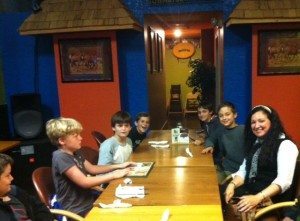The BCD World Languages Department welcomes Sra. Velez this fall as she leads our middle and upper school students through a daily immersion experience in her Spanish classes. Sra. Velez uses the TRPS (Total Physical Response Storytelling) methodology in her practice. A firm proponent of TPRS, Sra. Velez develops a highly comfortable setting in which her students learn to lean into the discomfort of wrestling with expressing themselves in a foreign language, all the while rapidly expanding their acquisition of vocabulary and more complex grammatical structures. The following excerpt explains TPRS:
“TPR Storytelling is a method for teaching foreign languages that was invented by Blaine Ray, a Spanish teacher in Bakersfield, California, in 1990. Concerned that his students were disinterested in the unexciting process of learning a language from a textbook, he began to use James Asher’s Total Physical Response to teach Spanish. Asher says that students acquire their second languages as they acquired their first languages. Our students learn as babies learn. Therefore, we should not expect them to produce the language before they have had an ample amount of time to listen to it. Blaine experienced great success, and the students began to be excited about his class. Although TPR has been the most effective method for acquiring a second language since it was invented in the 1960s, Blaine found that after hitting the “TPR wall,” he was unsure of what to do to move from the imperative to the narrative and descriptive modes of speech. He found that changing from commands to the third person singular allowed him to tell stories, a long-term memory technique. He found that asking the students to act out the parts of the characters in the stories preserved the highly effective physical element that had been so powerful in Classical TPR. As the technique was developed over the years, it became an all-encompassing method and methodology. The method combines Dr. James Asher’s Total Physical Response (TPR) with Dr. Stephen Krashen’s language acquisition strategies, allowing us to teach grammar, reading and writing along with vocabulary.
Why TPRS works:
The most important element of a successful TPR Storytelling program is the awareness that our focus is our students, not our book or even our story. A good relationship with students is the foundation of a TPRS program. We establish this connection by personalizing our stories. Every story is bizarre, in order to maintain the interest of our students, and personalized, because the only thing our students are truly interested in is themselves. The instructional pace should be based entirely upon an assessment by the teacher of how thoroughly the students have internalized the language. The number one, most important element in any TPRS program is the quantity and quality of the unconditional love, positive feedback, pats on the back and hearty applause provided to the students by the teacher.”
Cited from www.TPRstories.com
Recently, Sra. Velez put her students to their first test of oral immersion. Her Grade 5 students and their parents joined her for a dinner at Pancho’s in Pittsfield. Her students were expected to communicate in Spanish throughout the ordering process and beyond. Sra. Velez writes,
“The experience of going to Pancho’s with the fifth graders and their families was unique. It was a moment to get to know each other better, outside of the classroom, and to expose the students as much to the Spanish language as to its culture. The vocabulary needed to communicate in a restaurant was previously practiced and the students knew that they were to speak only in Spanish. They did not have any trouble identifying what they wanted to eat and ordering it. It was fantastic to see all of their family members sharing a meal together– an example of the larger BCD family we enjoy at our school.”




Awesome!